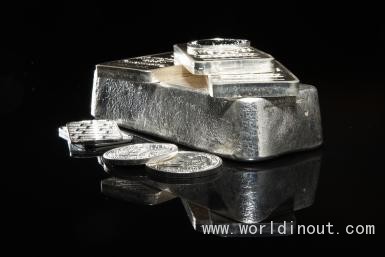
Silver was around $15.80 per ounce recently. While gold made all-time highs in 2011 -- silver's all-time high occurred in January 1980 at $50.36.
Throughout history, both silver and gold have held important positions in the global economy. Governments have used both gold and silver to back currency over the course of history. The gold standard and the silver standard have provided comfort or real value to paper currency in years gone by. Today, central banks, monetary authorities and supranational institutions continue to hold gold as a foreign currency reserve however, few if any hold silver for this purpose. Today modern governments do not use gold or silver to back currency value.
Silver is a highly speculative commodity.
Silver was around $15.80 per ounce recently. While gold made all-time highs in 2011 -- silver's all-time high occurred in January 1980 at $50.36.
Throughout history, both silver and gold have held important positions in the global economy. Governments have used both gold and silver to back currency over the course of history. The gold standard and the silver standard have provided comfort or real value to paper currency in years gone by. Today, central banks, monetary authorities and supranational institutions continue to hold gold as a foreign currency reserve however, few if any hold silver for this purpose. Today modern governments do not use gold or silver to back currency value.
Silver is a highly speculative commodity.ltimate currency or means of exchange in the world. Gold has been around as a currency for thousands of years, it has a longer history than any paper currency used in the world today. If gold is a competitor of paper currency, silver is a competitor of the change that we get for our currency notes when we buy something. Many of those coins were once made of silver. Gold and silver are both currency and industrial commodities.
When the Hunt brothers attempted to corner the market in silver back in the late 1970s a herd of buyers followed as the price of the precious metal moved aggressively higher. Silver rallied from under $10 per ounce to over $50 in a six-month period. More recently, silver rallied from under $10 per ounce in October 2008 to almost $50 by April 2011, a period of two and one half years.
As you can see, silver is highly volatile. That rally was the result of a combination of low interest rates, a weak U.S. dollar and a general bull market for commodity prices that caused increasing speculative interest in silver.
Raw material prices peaked in 2011 as the secular bull market that began in 2004 reached its apex. Since then, commodity prices have moved lower. NYMEX crude oil, which traded at $147 per barrel in 2008 and was above $100 in 2014, has fallen to under $50 per barrel recently. Copper, which peaked at over $4.60 in 2011, has declined to $2.30 in late September 2015. The price of silver has gone along for the plunge as silver has acted more like an industrial metal then a precious metal during the great commodity bear market that commenced back in 2011. As the global economic landscape has deteriorated over the past four years, the price of all industrial commodities has reflected this economic weakness.
Despite the historical tie between silver and gold prices, silver has underperformed gold over the past four years. This is partially because silver is a far more volatility commodity than gold. Quarterly historical volatility in silver is roughly 36% while the same metric stands at 18.26% for gold. Therefore, silver is twice as volatile as gold. The variance of the gold price is approximately half of silver. The silver-gold ratio is the number of ounces of silver value in each ounce of gold value. Over the past forty years, this relationship has averaged approximately 55:1. In 2011, when gold and silver traded to highs, the silver-gold ratio traded to lows of 38:1. A reading below the long-term average told us that silver was historically expensive relative to the price of gold at that time. In late October 2015, this ratio stood at just under 74:1. This tells us that based on historical norms; silver has become cheap relative to the price of gold. Therefore, one can conclude that silver is either too cheap at the current price level or gold is too expensive. We can attribute the move in this relationship to the fact that over time, silver is far more volatile than gold and that during bull and bear markets silver tends to move to extremes. Silver traded to a new six-year low in August 2015 when the price moved to lows of $13.91 per ounce.
Silver has been in a four-year bear market. The price has fallen precipitously during this period. Today the relative price level of silver tells us that either the precious metal is too cheap or that gold is going lower. However, given the continued economic lethargy in the world, specifically in China, which is the world's largest consumer of commodities, the prospects for silver continue to look weak and we may not have reached bottom yet.






